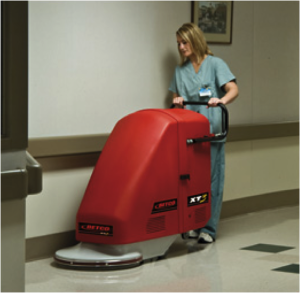The life cycle of floor care consists of three stages of maintenance processes that a typical floor undergoes as the floor is stripped, coated, maintained, and then eventually stripped again. A properly coated and maintained floor can essentially last indefinitely, avoiding costly stripping procedures. Most floors are often subjected to large amounts of traffic and soils, and a subpar maintenance program causes the life of the floor finish to diminish quickly.

The three phases of the life cycle of floor care are routine, interim and restorative maintenance. This blog will address the procedures used in phase one, routine maintenance.
How to Extend the Life of Your Floor Finish with Routine Maintenance
Appropriate routine maintenance is necessary to maintain the desired appearance level of the floor and to extend the time between more costly Interim and Restorative Maintenance Procedures. Maximum floor appearance can only be achieved when the floor finish is as clean and smooth as possible. A properly coated floor with a smooth clean surface protects the floor, providing excellent shine and easier maintenance. As the floor is exposed to foot traffic, hand carts and soils, the surface film is slowly abraded, causing wear. Soils penetrate the protective finish causing the film to become rough, less slip resistant and less reflective. In order to extend the life of the floor finish, routine maintenance needs to be performed.
5 Tools Needed for Routine Maintenance
- Floor Matting: A proper routine maintenance plan should include the use of adequate floor matting to prevent damaging soils from being tracked onto the floor. A majority of these soils are tracked in from the outside and keeping them at the entrance is an effective first step to keep your floors looking great.
- Daily Vacuuming: The entrance matting should be vacuumed on a daily basis in order to remove any soil that could make its way onto the floor.
- Dust Mopping: Removes soil and debris which can cause premature wear of the floor finish.
- Daily Damp Mopping (or automatic scrubbing): Use a neutral or daily cleaner to remove soils that a dust mop may leave behind.
- Restorers: When daily mopping no longer produces desired appearance levels, a restorer should be used to clean and condition the top layer of finish. Restorers are products that clean while restoring the top layer of finish. The floor is then burnished, which restores it to a smooth, reflective shine. This process also extends the time before the Interim Maintenance method of top scrubbing and recoating needs to be performed.
Routine maintenance can be performed as long as the floor meets your desired appearance standards. Once routine maintenance no longer produces the results you would like, it is then time to move onto the second phase, interim maintenance. Stay tuned for part II, where all the steps to interim maintenance will be discussed.